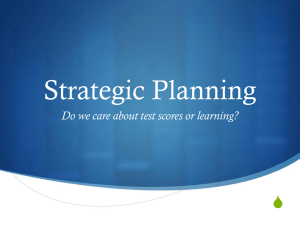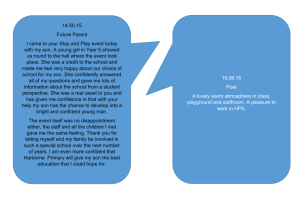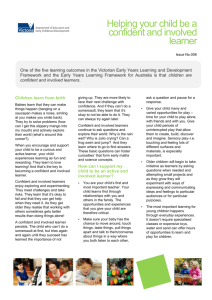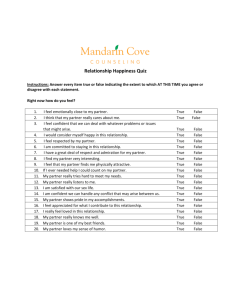Course Booklet - Saint Roch's Secondary School
advertisement
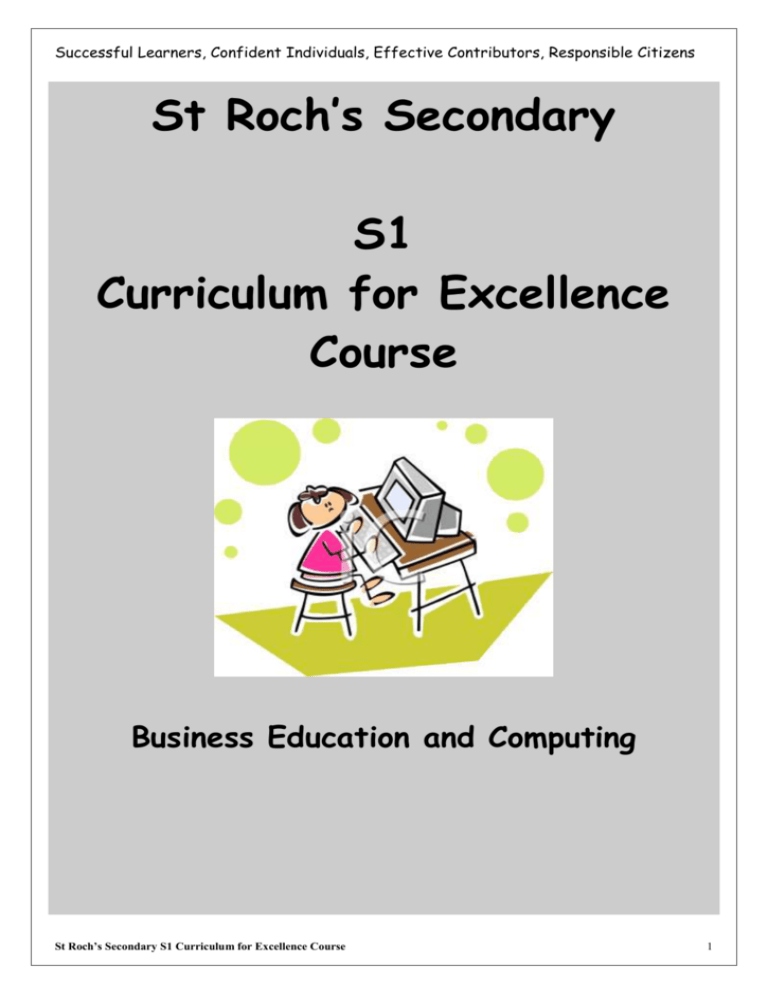
Successful Learners, Confident Individuals, Effective Contributors, Responsible Citizens St Roch’s Secondary S1 Curriculum for Excellence Course Business Education and Computing St Roch’s Secondary S1 Curriculum for Excellence Course 1 Successful Learners, Confident Individuals, Effective Contributors, Responsible Citizens Topic 1 - Needs and Wants What is the difference between a Need and a Want? A need is something we really need to survive A want is something we would like to have – it is over and above what we need to survive. Remember – although you might say you need something – you probably actually just want it! Task 1 Identify the following as either a need or a want. () Item Need Want Chips Strawberry Milkshake Holiday Secure/sheltered place to live Designer Jacket Clothes Car Basic Food such as bread Fluids – water Air St Roch’s Secondary S1 Curriculum for Excellence Course 2 Successful Learners, Confident Individuals, Effective Contributors, Responsible Citizens Task 2 Why do you think these needs are needs and not just wants? Need Why is it a need? Wheat Drinking Water Weather Proof-Clothing Lockable building, sheltered to keep out bad weather Task 3 Write down five needs and wants you have had over the last week Needs St Roch’s Secondary S1 Curriculum for Excellence Course Wants 3 Successful Learners, Confident Individuals, Effective Contributors, Responsible Citizens How have needs and wants changed over time? There are many items we use in our everyday lives which we think of as needs. However, in years gone by this might not always have been the case. As our society has been come richer, items that used be wants have become needs (maybe!) Here are some examples: Mobile Phones Television Washing Machines Central Heating In countries like Scotland, some people are still considered to be poor. However, this poverty is called relative poverty. This is different from being poor in countries such as African nations such as Ethiopia. In a country such as Ethiopia many people still die of starvation. In Scotland it is pretty unlikely that someone will die of starvation but yet some people are considered to be relatively poor – relative to other people in Scotland. Nowadays it is considered that in countries with relative poverty, there is a tendency for poorer families to eat much less healthily than wealthier families – they don’t actually starve. Task 4 The following countries experience either relative or actual poverty. Identify which ones belong to each category. Country Actual Poverty Relative Poverty Somalia France Irish Republic Malawi Spain Darfur St Roch’s Secondary S1 Curriculum for Excellence Course 4 Successful Learners, Confident Individuals, Effective Contributors, Responsible Citizens Task 5 Make a list of five things which are commonplace in today’s society which would not have been around when your mum/dad/granny/grandpa were young. Item When was this invented/became commonplace in people’s homes St Roch’s Secondary S1 Curriculum for Excellence Course 5 Successful Learners, Confident Individuals, Effective Contributors, Responsible Citizens Topic 2 - Goods and Services What are Goods? Goods are something we can see and touch. We buy goods from shops and other places. We think of some goods as being needs such as water and wants such as muffin. Here are some examples: Mobile Phone Desk Water Chocolate Sometimes goods are made up from other goods. For example – Strawberry Jam is made up from Strawberries, Sugar etc. Strawberries for example can be used to make yoghurts, milk shakes etc. Task 1 These fruits/vegetables can be made into something else. Fruit/Vegetable Alternative Use Potatoes Raspberries Peaches Apples Oranges Onions Tomatoes Faculty of Business Education/Computing – Encouraging Excellence 6 Successful Learners, Confident Individuals, Effective Contributors, Responsible Citizens Task 2 In the table provided list whether the goods are sold in packets, boxes, bottles, tins, jars or no packaging at all (you can list more than one if you need to) Goods Description of how sold Soup Cereal Mushrooms Milk Tomatoes Cooked Meats Task 3 List three types of goods you think are made in Scotland. Goods Made in Scotland Faculty of Business Education/Computing – Encouraging Excellence 7 Successful Learners, Confident Individuals, Effective Contributors, Responsible Citizens What are Services? We know that a good is something we can see and touch. Some companies provide services – that means that they do something for us. We cannot see and touch them. Here are some examples: Hotel Haircut Bus journey Car cleaning Pop Concert Many jobs in Scotland are within the service sector. These mainly consist of banking, tourism and insurance. In the past many of Scotland’s jobs were made up from producing goods such as Ships, Coal and Textiles but now these industries are virtually non existent. However, there has even been a decline in the last few years in service industries such as banking because of the present economic climate. Task 4 Look at the descriptions of services shown below. Identify each service provided. Description Type of Service I collect busy people’s crushed garments and return them smooth and ready to wear. I show visitors the sites in and around Edinburgh. I turn people’s untidy gardens into something neat and tidy. I give advice on how house’s should be designed and built. I make people’s fingernails attractive. I fight fires and give advice on fire prevention. Faculty of Business Education/Computing – Encouraging Excellence 8 Successful Learners, Confident Individuals, Effective Contributors, Responsible Citizens Task 5 The workers below provide us with either goods or services. But who provides what? () Description Goods Service Work in car factory Waiter in restaurant Hairdresser Farmer Pilot Teacher Faculty of Business Education/Computing – Encouraging Excellence 9 Successful Learners, Confident Individuals, Effective Contributors, Responsible Citizens Topic 3 - Entrepreneurs Factors of Production There are four factors of production: Factor of Production Description Land This is the land necessary to produce the goods. This is the manpower that goes into producing a good. This is the money, equipment etc required to start a business. This is the business idea that allows the other factors to be brought into place in order to start the business. Labour Capital Enterprise What is an Entrepreneur? An entrepreneur is someone who: Comes up with a good idea for a business Organises all the elements needed for the business to work Takes a risk by putting time and money into the business There are no qualifications needed to become an entrepreneur, in fact man entrepreneurs have no formal qualifications but they do have vision, imagination, drive and are innovative in their approach. Entrepreneurs bring wealth to the country by setting up businesses which in turn create jobs and put money into the economy via taxation. Often entrepreneurs are rewarded with awards and title i.e. Alan Sugar is now Lord Alan Sugar. Faculty of Business Education/Computing – Encouraging Excellence 10 Successful Learners, Confident Individuals, Effective Contributors, Responsible Citizens Task 1 Do you know any of the following entrepreneurs, the name of their business, what line of business they are in and is it goods or services? Entrepreneur Name of Business Line of Business Goods or Services? Richard Branson Alan Sugar Michelle Mone Tom Farmer Tom Hunter Duncan Bannatyne Bill Gates Task 2 Now see if you can think of some other entrepreneurs not listed above. Entrepreneur Name of Business Faculty of Business Education/Computing – Encouraging Excellence Line of Business Goods or Services? 11 Successful Learners, Confident Individuals, Effective Contributors, Responsible Citizens Topic 4 – Business Organisation Types There are different types of business organisations: Private Public Voluntary (third sector) These organisations exist for a variety of reasons: to make profits to provide a public service for charitable reasons Type Public Sector Examples Public Sector organisations include schools, the police, the BBC etc. Aims Provide a Service Private Sector Private Sector organizations include John Lewis, McGhees the Bakers, Get Stuffed etc. Make a Profit Third Sector (voluntary sector) Third sector organizations include Oxfam, Sciaf, Cancer Research etc. To help people and make a difference Task 1 In your jotter make a list of three different organisations for each of the organisation types listed above. Research their website to try and come up with a list of aims/objectives for each type of organisation. Faculty of Business Education/Computing – Encouraging Excellence 12 Successful Learners, Confident Individuals, Effective Contributors, Responsible Citizens Topic 5 – Types of Business When deciding to set up your own business you need to decide which type of business you want to be. Type Sole Trader Description Owned and controlled by one person. The owner will provide all the funds to start up the business – this is known as the capital. Partnership Can have between 2 and 20 owners or partners. Advantages Easy to set up Keep all the profits Make all the decisions Limited Company Owned by shareholders, who may or may not be involved in running the company. Disadvantages Difficult to get time off If the business fails you may lose everything you own Risk and responsibilities shared More capital can be raised More expertise brought into business If the business fails you only lose the money you put in Easy to raise more money Have to share the profits Make be disagreements about how to run business If the business fails you may lose everything you own Expensive to start People running the company may disagree Task 1 Working with a partner, make a list of five organisations which fit into each of three business types listed above. Use the Internet to research possible busniness types. Your teacher will suggest some possible websites. Faculty of Business Education/Computing – Encouraging Excellence 13 Successful Learners, Confident Individuals, Effective Contributors, Responsible Citizens Topic 6 – Marketing Your Product The Marketing Mix The marketing mix is known as the 4 Ps: Price Product Place Promotion PRICE PRODUCT TARGET MARKET T PLACE PROMOTION Price Must be set at a level that consumers are willing to pay for the goods but also enable the organisation to make a profit. Product This must be what the consumers want and must do what they want it to do. Place The process by which the product reaches the market in the right place, at the right time and in the right quantity. Telling the consumers about the product and enticing them to buy it through advertising and promotion. Promotion Task 1 Pick a business you are familiar with and write down what products/services they sell, where they sell their goods, how they promote their goods and what sort of prices they charge (are they a discount brand or do they charge big prices etc). Faculty of Business Education/Computing – Encouraging Excellence 14 Successful Learners, Confident Individuals, Effective Contributors, Responsible Citizens Topic 7 – Price The price of an item is the amount of money that it costs to purchase a product. Profit is the amount of money a business makes from making/selling the product. The purchase price of a product is dependent on a number of factors: How much it costs to buy a product or make the product? How much other businesses are charging for the same type of product? Whether the product is new to the market or established in the market? What market you are targeting your product to? How much profit the business wants to make? Task 1 Check the websites of Tesco, Asda and Sainsburys to compare the prices of 5 different everyday products (milk, sugar, bread etc). Remember to use the same brand, size etc when comparing products. Write down your findings. Product Faculty of Business Education/Computing – Encouraging Excellence Tesco Price Asda Price Sainsbury Price 15 Successful Learners, Confident Individuals, Effective Contributors, Responsible Citizens Task 2 In pairs, discuss why you think the prices for similar products might be different. You should come up with a list of as many factors that have meant the prices are different. Factor 1. 2. 3. 4. 5. We all pay for goods every day but how do companies decide on the price to charge for the products they sell. They will obviously want to charge a price which will allow them to make a profit. However, if their prices are too high then their customers will shop about and find another company which charges less. To decide on a selling price each company must first work out how much it costs them to produce the goods they are selling. The costs of making the goods can be split into 3 different elements: Materials – the resources needed to make the product Labour – the money paid to the workers making the product Expenses – the payment for rent, insurance, light and heat etc For example, a company making desks would have to pay for the following: Materials - wood Labour - wages for joiners Expenses - lighting and heating costs of the factory Faculty of Business Education/Computing – Encouraging Excellence 16 Successful Learners, Confident Individuals, Effective Contributors, Responsible Citizens Task 3 Write down another 2 costs for each of the 3 elements when making a desk. Material Labour Expenses Task 4 The Rochco Fruit Juice Company had the following costs when they produced 20,000 bottles of apple fruit juice: Wages of the fruit pickers Insurance of the factory Bottles Apples Wages of the bottlers Packers’ wages Light and Heat of the Factory Sugar £11,000 £8,000 £3,000 £600 £9,000 £6,000 £2,000 £400 Write down which items are materials, labour or expenses Materials Labour Faculty of Business Education/Computing – Encouraging Excellence Expenses 17 Successful Learners, Confident Individuals, Effective Contributors, Responsible Citizens The total cost of making 20,000 bottles of apple fruit juice was £40,000. We can work out the cost of making one bottle of fruit juice by dividing the total cost by the number of bottles made: £40,000 ÷ 20,000 = £2 per bottle If the Rochco Fruit Juice Company sold each bottle of apple fruit juice for £2 each they would only cover the costs of making them. To make a profit they must sell them for more than £2 each. The extra which is added on to the cost price to give a profit is usually expressed as a percentage and is known as the “Mark-up”. If they decided to have a 50% mark-up this would mean adding on an extra 50% of the cost price to give the Selling Price. The Selling Price would therefore be calculated as: Cost Price £2 + (£2 x 50%) £1 = £3 Task 5 The Rochco Fruit Juice Company sells different flavours of fruit juice and has different costs and mark-ups for each. Using a calculator, work out the selling price for each type of fruit juice: Type of Juice Banana Strawberry Apricot Mango Raspberry Cost Per Bottle Mark-up £4 £3 £5 £4 £6 25% 20% 50% 20% 25% Selling Price £ Although most companies would like to have a high mark-up to give them a big profit on the goods they sell, they have to be careful that rival companies are not selling the same products at a lower price. Most companies – especially supermarket chains - check each others prices regularly to try to undercut their rivals and therefore get more customers. Faculty of Business Education/Computing – Encouraging Excellence 18 Successful Learners, Confident Individuals, Effective Contributors, Responsible Citizens Topic 8 – The Product It is important to take time to make sure that you have a product to sell that people will actually want to buy. You might need to think about what range of people you think will be interested in buying your product – known as your target market. You might decide to target your market based on a number of different factors. This could be based on – age, income level (how much money a person earns), class (working, middle or upper class), even things perhaps like geographical area. Making the Product In order to complete a product you will need inputs – this might be materials, labour or any machines. The process will be what it takes to complete the finished product. The output will be the finished product ready for sale. If you are creating a product – you must decide whether you are going to make the product by hand or by machine. You must also decide how many items you will need to produce. When your producing goods as ‘one offs’ – goods tend to be made by hand. However, many of the goods that we buy for our homes or wear tend to be mass produced. This means that the goods will usually have been created by a machine at some stage in their production. When we make goods by hand – it is known as labour intensive. When goods are made mainly by machine, they are known as capital intensive. Goods which are mass produced by machines are normally far cheaper than ones that have been created by hand. Faculty of Business Education/Computing – Encouraging Excellence 19 Successful Learners, Confident Individuals, Effective Contributors, Responsible Citizens Task 1 In the table below write down the name of five products and list what group of people you think the products might be targeted at. Product Target Market Task 2 Do you think the following products are labour intensive or capital intensive? Product Labour Intensive/Capital Intensive Wedding Dress School Shirts Birthday Cakes Loaves of Bread Luxury Car Bricks Faculty of Business Education/Computing – Encouraging Excellence 20 Successful Learners, Confident Individuals, Effective Contributors, Responsible Citizens Task 3 In the spaces below draw what you think the inputs would be for each product, the process that takes place to make/produce it and the finished product. Show any materials, machines or people used in the process. Three products have been selected for you – see if you can think up another of your own. Input Process Output Product: Getting an exam pass Product: Making a cake Product: Building a house Faculty of Business Education/Computing – Encouraging Excellence 21 Successful Learners, Confident Individuals, Effective Contributors, Responsible Citizens Topic 9 – Place (Where the Product is Sold) Where a business chooses to set up (its location) is very important. For example a shop might need to be in a place where there will be a lot of passing trade or situated close to a housing estate so that there will be a lot of potential customers. Often producers/sellers of particular items are located next to where their raw materials are found, or where there is access to a large number of customers, or where there are good roads, rail links etc (called infrastructure). Indeed you have to make sure there are not any competitors near by. Businesses might decide where to set up based on the cost of the premises (shops, workshops etc). Premises in the city centre, perhaps close to busy shopping areas and good transport links will be higher priced than outlets outwith the centre. Of course some businesses may not need to be close to city centre as some of their custom may be done by post, telephone or even buying and selling over the Internet (called E-Commerce). Task 1 Look at the following types of business and give a reason why each of the businesses are located where they are. Business Location Shoe Shop High street location Timber Yard Near the forest Hotel Near tourist attraction Garage On busy road Shopping Centre Close to motorway Faculty of Business Education/Computing – Encouraging Excellence Reason 22 Successful Learners, Confident Individuals, Effective Contributors, Responsible Citizens Task 2 About twenty years ago Disney decided to locate a theme park in Europe – it decided that Paris would be the best location. Today this is known as Disneyland Paris. With a partner discuss the following and come up with a suitable answer. Discussion Question Reason Why do you think that Disney did not consider Scotland to set up? Why do you think that Paris was a good location for Disney? What benefits do you think there has been to France in having Disney setting up Disneyland Paris in their country. Task 3 Name three businesses that have a shop as well as online – list their websites. Then see if you can think of two businesses that trade only online. Name of Business Website Online/Both What do you think the benefits are for a business and for a customer of buying goods online? List two advantages for each. Advantage to Business Faculty of Business Education/Computing – Encouraging Excellence Advantage to Customer 23 Successful Learners, Confident Individuals, Effective Contributors, Responsible Citizens Topic 10 – Promoting Your Product Promotion is all about telling consumers about your products/services. It is all very well to have a good product but if no one knows about it then it will not sell! Businesses use a number of different ways in order to promote their products – television, radio, Internet, posters, leaflets, emails etc. The best to market a product is to pick the best features of the product/service and highlight them to the consumer so that they might want to use it. Task 1 Look at the five shops/products/services below and state what you think might be the best way to promote it – be sure to give a reason for your answer. Product Promotion Reason Get Stuffed Colgate Toothpaste Grand Hotel, Ayr Dell Computers Task 2 You will be given thirty minutes to search the Internet – looking at various websites/ advertisements for products/services/shops you use regularly. Pick one that you like and think is the most effective. Think about the market they are trying to attract, the colours they have used, strap lines etc. Product Name Reason for Choice Faculty of Business Education/Computing – Encouraging Excellence 24

